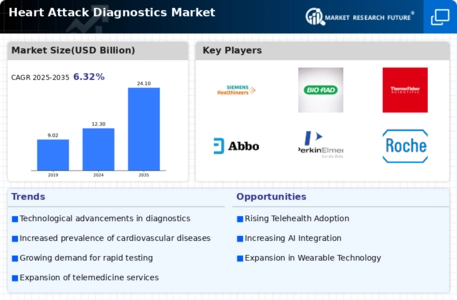Growing Geriatric Population
The expanding geriatric population is a crucial factor influencing the Heart Attack Diagnostics Market. As individuals age, the risk of developing cardiovascular diseases escalates, leading to a heightened need for effective diagnostic solutions. The World Health Organization projects that the number of people aged 60 years and older will double by 2050, which could significantly impact healthcare systems. This demographic shift necessitates the development of tailored diagnostic tools that cater to the unique needs of older adults. Consequently, the Heart Attack Diagnostics Market is likely to experience growth as healthcare providers adapt to the increasing demand for age-appropriate diagnostic services.
Rising Healthcare Expenditure
The upward trend in healthcare expenditure is another driving force behind the Heart Attack Diagnostics Market. As countries invest more in healthcare infrastructure and services, there is a corresponding increase in the availability and accessibility of diagnostic tools. This trend is particularly evident in emerging economies, where rising incomes and improved healthcare policies are facilitating greater access to advanced diagnostic technologies. Furthermore, increased spending on preventive healthcare measures is likely to enhance the demand for heart attack diagnostics, as early detection becomes a priority. As a result, the Heart Attack Diagnostics Market stands to benefit from this growing investment in healthcare, which is essential for improving patient outcomes.
Government Initiatives and Funding
Government initiatives aimed at reducing the burden of cardiovascular diseases are playing a pivotal role in shaping the Heart Attack Diagnostics Market. Various health organizations are allocating significant funding towards research and development of innovative diagnostic tools. For instance, initiatives that promote public awareness about heart health and encourage regular screenings are likely to increase the demand for diagnostic services. Additionally, policies that support the integration of advanced technologies in healthcare settings further stimulate market growth. As governments worldwide recognize the importance of early detection in improving health outcomes, the Heart Attack Diagnostics Market is expected to benefit from increased investments and supportive regulatory frameworks.
Advancements in Diagnostic Technologies
Technological innovations are significantly transforming the Heart Attack Diagnostics Market. The introduction of advanced imaging techniques, such as cardiac MRI and CT angiography, has improved the accuracy and speed of heart attack diagnosis. Moreover, the development of biomarker tests, which can detect heart damage at a molecular level, is revolutionizing the diagnostic landscape. These advancements not only enhance the precision of diagnoses but also facilitate timely interventions, which are crucial in emergency situations. As healthcare facilities increasingly adopt these cutting-edge technologies, the Heart Attack Diagnostics Market is poised for substantial growth, driven by the demand for more reliable and efficient diagnostic methods.
Increasing Prevalence of Cardiovascular Diseases
The rising incidence of cardiovascular diseases is a primary driver for the Heart Attack Diagnostics Market. According to recent statistics, cardiovascular diseases account for a substantial portion of global mortality rates, with heart attacks being a leading cause. This alarming trend has prompted healthcare systems to prioritize early detection and diagnosis, thereby increasing the demand for advanced diagnostic tools. As the population ages and lifestyle-related risk factors such as obesity and diabetes become more prevalent, the need for effective heart attack diagnostics is likely to grow. Consequently, this surge in cardiovascular conditions is expected to propel the Heart Attack Diagnostics Market forward, as healthcare providers seek innovative solutions to enhance patient outcomes.

















Leave a Comment